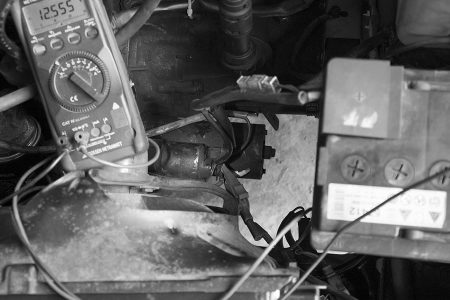Starter motor broken?
The diagnosis “car won’t start” is admittedly rather simple and can also be made by simple-minded people. However, it is not so easy to say what is wrong with this small motor; in principle, there are three different routes to follow from here:
Starter does nothing
The classic case. You jump in the car in the morning, turn the key, nothing happens. Nothing at all. The Christmas tree in the dashboard at full power. If the fuses in the fuse box have been checked, the magnetic switch is now the main suspect. He leads the power to the electric motor and engages it in the flywheel. Remedy: Remove starter, check solenoid switch.
Still turning, but low starting power
If the starter only gets the crankshaft going with difficulty despite a fresh or freshly charged battery, it is likely that the actual engine is ready for an overhaul: remove the starter and dismantle it. Does the battery have enough power?
Spins empty, cracks, can only be motivated to start by knocking or repeatedly switching on
The clutch or the freewheel no longer work. The search starts with the magnetic switch, the freewheel should also be checked. Alternatively, the pinion of the starter motor or the ring gear in the clutch bell may be defective – this is a rare occurrence.


Check magnetic switch
A flawless starter motor can draw 500 amps or more on a dark winter’s night with a full battery and thick multigrade oil. This performance requires not only pencil-thick cables, but also corresponding switches and switching contacts. In our starter, this switch is little more than a simple electromagnet that attracts a steel piston.
A copper plate sits on the underside of the starter motor, which establishes the connection between the positive and the starter motor: Ignition!
The three vital connections of the starter are located on the magnetic switch. Connection number one is the large grub screw with the small “30”: Permanent plus. This terminal is so generously dimensioned because it supplies the starter with power. Terminal 30 is connected directly to the vehicle battery without a fuse. To the left of this is connection number two, the output of the large magnetic switch.
It is connected to the actual electric motor by means of a copper braided cable. As soon as the coil is energized, voltage is also applied to this terminal – the electric motor is energized and turns.
Connection number three is the smaller threaded pin with the terminal designation 50. Often has additional cable lugs.
This is the pulse line; it carries current when the starter motor is to start. If you apply power here, the coil of the magnetic switch is energized: click, coil pulls the piston, contact closes, motor turns.


Letzte Aktualisierung am 2024-04-05 / Affiliate Links / Bilder von der Amazon Product Advertising API
Solenoid switch out of order?
If the coil of the magnetic switch is energized but does not switch, there is an audible “click!” – at the output (the copper wire that goes over to the electric motor), but there is no voltage. Or not enough of it.
To ensure that the starter motor spins the V6 biturbo as it once did in May, the multimeter should read at least 8 volts here.
If it does not: Remove the starter motor and replace or repair the solenoid switch.

Starter motor broken?
Starter motors are usually built to last half an eternity. However, only as long as the carbons are in order and supply the windings with current.
In this case, the “carbons” are actually graphite pins that run on the collector of the DC motor. It’s only logical that these pens melt faster in Berlin’s cab business with its permanent start-stop than in Grandma Johnsons old Civic, which is fired up once a month for the trip to the chiropodist.
The exact diagnosis “electric motor dead” can only be made once the thing has been removed and dismantled on the workbench.

Remove starter
Starter motors are baked in two typical designs: either “free-cutting” or with a small bell in which the free end of the starter shaft is supported once again. Both are typically mounted in or on the clutch bell housing of the transmission and can be lifted out of the beloved vehicle as soon as you have unscrewed two or three more or less long screws.
It is possible that the designer also used these screws as engine mounts: Supporting the engine.
Because the starter motor can draw more than 500 amps of short-circuit current, depending on the variant, there is NO fuse between it and the starter battery.
The strip at terminal 30 therefore acts as a genuine positive battery terminal and is ideal for setting your own car on fire or at least creating a formidable golden shower in the dim light of the grease pit.
ALWAYS disconnect the battery before working on this terminal – only then loosen any screws on the starter motor.


Letzte Aktualisierung am 2024-04-03 / Affiliate Links / Bilder von der Amazon Product Advertising API









